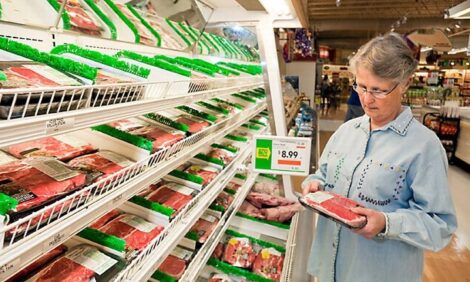



Market Preview: Pork Demand Signals Offer Hope
US - Weekly US Market Preview provided by Steve R. Meyer, Ph.D., Paragon Economics, Inc.Finally some good news: The University of Missouri’s demand indexes for the three months from November 2008 through January 2009 are all higher than one year ago, some of them sharply so. Table 1 shows Professor Glenn Grimes’ computed percentage changes in demand indexes for the period.

Both pork and hog demand were positive for the period with pork demand gaining 2 per cent and hog demand gaining 1 per cent. Some may wonder how that squares with current market conditions and all of the dire news we hear, but there are good reasons that the numbers came up positive. Consider:
- These numbers are for November through January and do not reflect the lack of strength we have seen in cash markets and marked weakening of futures markets over the past few weeks.
- The computations use real (i.e. deflated) retail prices. This process almost always results in converting a nominal price to a smaller number due to inflation. That lower number can mean lower demand unless domestic disappearance numbers increase pretty rapidly. From November through January, inflation was actually negative during this time with the Consumer Price Index (CPI) falling by over six points or about 3 per cent. That means that real prices did not fall much at all and that makes the demand index more positive.
- Assuming January exports and imports were similar to those of December, which Professor Grimes did, January per capita disappearance (or consumption) was 3 per cent higher than that of December and 3.4 per cent higher than one year ago. Those numbers are largely the result of slowing exports – but it was robust exports that forced per capita consumption lower last summer and contributed to the indexes for 2008 looking so bad.
- The lagged effect of last summer’s shorter domestic supplies on retail prices is just not being felt. Retail prices actually fell during the period in question here, but they did not fall by as much as usual, especially when one considers that there was actual deflation during the time period. I have stated several times in these columns that the impact of lower domestic supplies last summer would eventually be seen in retail prices and these computations bear that out, I think.
January’s improvement is quite clear in Figure 1, a chart of monthly real per capita pork expenditures, a figure closely akin to Professor Grimes’ demand indexes. The January figure of $11.03/person is over 8 per cent higher than January 2008.

And why is hog demand lagging behind domestic retail demand? Primarily due to slower exports. Remember that hog demand is driven by domestic pork demand, export demand and packer margins. The hog demand index was helped relative to one year ago by domestic demand, hurt by export demand and helped by the very low packer margins of November through January. You might recall last week I termed them “abysmal.“ The last of those can’t continue much longer, so either exports or domestic demand are going to have to carry more of the hog demand “water“ in future weeks.
The largest caveat I can see is that these figures represent a relatively short time period. One quarter can be quite different than one year and one quarter definitely does not make a trend. But this piece of good news among all of the gloom is still welcome.
Packer Retrospective
In retrospect, I hope the people at Smithfield Foods were not upset about my characterization last week of their plant at Sioux City as “vulnerable“. And if any of them were, I apologize. I was not really trying to point out which plant was or was not most subject to operational pressure should hog supplies get tight. The point I was really trying to make was that even in highly uncertain times, and at a time when they were making major changes in their business structure, Smithfield chose not to take any action regarding any of its slaughter operations. That, to me, is a clear statement of where they think the business is going and a huge positive for the US pork industry.
Meat processing plants are pretty flexible. The same types of machinery are used to make many processed meat products regardless of the critter from which the meat comes. But slaughter plants are, today, species specific and hardly any pork plant that has once been closed has ever reopened. So keeping them running is critical. Let’s hope that happens through this year and into better times – which I really believe are ahead.










